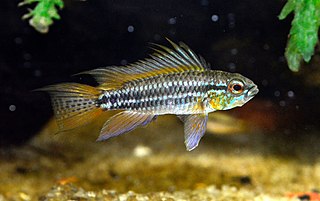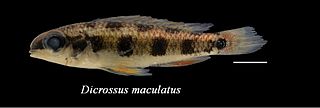
Cichlasoma is a genus of freshwater fish in the cichlid family. The genus was previously very large, including cichlids from North America, including Central America, and South America.

The green terror is a colorful freshwater fish in the cichlid family. The fish originates from the Pacific side of South America from the Tumbes River in Peru to the Esmeraldas River in Ecuador. It is polymorphic and can have white or gold-orange edging to the tail and dorsal fins. It has historically been confused with two other species that always have narrow, clearly defined white edging, the more southerly distributed A. stalsbergi and the more northerly A. blombergi.

Crenicichla is a genus of cichlids native to South America commonly known as the pike cichlids. They are found in most tropical and subtropical freshwater habitats between the Andes and the Atlantic.

Apistogramma is a large genus of freshwater fish in the family Cichlidae found in South America, but also commonly kept in aquariums. They are dwarf cichlids that mostly feed on tiny animals and have breeding behaviors that vary depending on the exact species.

Aequidens is a genus of fish in the family Cichlidae found in South America. Formerly a wastebasket genus, as presently defined Aequidens is largely restricted to the Amazon Basin, Orinoco Basin and river basins in The Guianas. The only exceptions are A. plagiozonatus which also occurs in the Paraná Basin, and A. tetramerus which also occurs in the Parnaíba River.

Geophagus is a genus of cichlids that mainly live in South America as far south as Argentina and Uruguay, but a single species, G. crassilabris is from Panama. They are found in a wide range of freshwater habitats. They are part of a group popularly known as eartheaters and mostly feed by picking up mouthfuls of sediment to sift out food items such as invertebrates, plant material and detritus. The largest species reach up to 28 cm (11 in) in standard length. They are often kept in aquariums.

Heros is a genus of cichlids native to the Amazon, Orinoco and Essequibo River basins in South America. They were previously included in the genus Cichlasoma before its restriction to the distinct group of "Port Cichlids."

Dicrossus is a genus of small cichlid fishes native to rivers in the Amazon and Orinoco basins in South America. These cichlids have several dark spots on the sides of their bodies. Depending on the species, they typically only reach 4–7 cm (1.6–2.8 in) in length.

Bujurquina is a genus of cichlid fish endemic to South America. Most species in the genus are restricted to the western Amazon Basin. The only exceptions are B. mariae from the Orinoco Basin, and B. oenolaemus and B. vittata from the Paraguay–Paraná Basin.
Heros severus, is a species of tropical freshwater cichlid native to the upper Orinoco and upper Rio Negro basins in South America. It has historically been confused with several other species in the genus, most recently H. liberifer.

Nannacara is a genus of small freshwater cichlid fish endemic to South America. The genus is part of the Cichlasomatini tribe of the Cichlasomatinae subfamily. In the aquarium hobby, the fish is considered a dwarf cichlid along with Apistogramma, Mikrogeophagus, and Dicrossus species. Nannacara anomala is the most commonly encountered species in the aquarium trade.

Laetacara is a small genus of cichlids native to freshwater habitats in tropical and subtropical South America, ranging from the upper Orinoco River basin in Venezuela to the Paraná River basin Argentina. The genus is also collectively known as the smiling acaras. Like all cichlids, Laetacara species have well-developed brood care.

Mesonauta, the flag cichlids, is a small genus of cichlids native to the Amazon, Orinoco, Essequibo, Paraná and Paraguay basins in South America. Mesonauta is included in the subfamily Cichlasomatinae. They occur in various freshwater habitats such as streams and lakes, especially in areas with little water movement and aquatic vegetation. They are generally found in small groups that stay near the water surface. To avoid predators, adults may jump out of the water and juveniles mimic leaves.

Apistogramma nijsseni is a species of cichlid fish, endemic to highly restricted local black water habitats in the Quebrada Carahuayte, a small stream in the Ucayali River drainage, southern Peru. The male reaches a maximum length of 8 cm (3 in), the female remaining somewhat smaller. Apistogramma brooding females assume a bright yellow and black aposematic coloring: in A. nijsseni, unusually, a healthy, unstressed female retains this coloring. The species is popular aquarium fish amongst dwarf cichlid hobbyists, though it does not often appear in the general pet fish market.

The Cichlasomatinae are a subfamily of cichlid fishes, including all ciclids native to the Greater Antilles, United States, Mexico and Central America, and many of the cichlids from South America. The subfamily Cichlasomatinae is often divided into two tribes: Cichlasomatini and Heroini, however some authorities classify these two tribes as part of the wider Neotropical and marginally Nearctic subfamily Cichlinae.

The blue acara is a very colorful freshwater fish in the cichlid family. This fish can be found in various freshwater habitats, ranging from standing water to flowing streams, in Venezuela and Trinidad. They can reach lengths of 16 cm (6.3 in). The scientific species name is indicative to its looks; pulcher meaning "beautiful" in Latin. The blue acara is a common cichlid sold in many aquarium stores, and is sometimes confused with the larger green terror.

Heroini is a fish tribe from the Cichlasomatinae subfamily in the cichlid family. All cichlids native to the Greater Antilles, United States, Mexico and northern Central America are members of this tribe. It also includes most cichlid species in southern Central America and several species from South America. A large percentage of its species were formerly placed in the genus Cichlasoma, but have since been moved to other genera.
Andinoacara stalsbergi is a species of South American freshwater fish in the family Cichlidae. It was previously included in A. rivulatus, but was described as a separate species in 2009. The specific name honours the Norwegian aquarist Alf Stalsberg who collected the type of this species and who has had a “longstanding commitment to increase the knowledge about cichlid fishes”.

Cichlastomatini is a tribe of cichlids from South America, one of two tribes that make up the subfamily Cichlasomatinae. They were recognised in 1983 as an assemblage by the Swedish ichthyologist Sven O. Kullander by their four rather than five 5 dentary foramina in the lateralis canal system of the head, describing them as closely related to the genus Cichlasoma. Melanie Stiassny suggested that these fishes recognised as a clade by Kullander were divided into two groupings in 1991 which she termed cichlasomines and heroines, Kullander formally raised these to the tribes Cichlasomatini and Heroini of the subfamily Cichlasomatinae in 1999. In other classifications the tribe Cichlasomatini is placed in the subfamily Cichlinae.

Geophagini is a tribe of cichlids from the subfamily Cichlinae, the American cichlids. It is the sister taxon to the clade which includes the Cichlasomatini and Heroini. Fishes in the Geophagini are distributed from Panama south to Argentina, it is the most speciose of the seven tribes within the Cichlinae and it is subdivided into three sub-tribes, Acarichthyina, Crenicaratina, and Geophagina which together contain over 200 species. Geophagines show morphological and behavioural specialisations to enable them to sift the substrates within their mouths so that they can separate benthic invertebrates from substrates dominated by sand or silt.

















